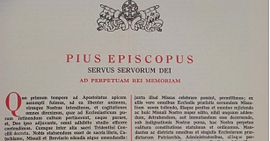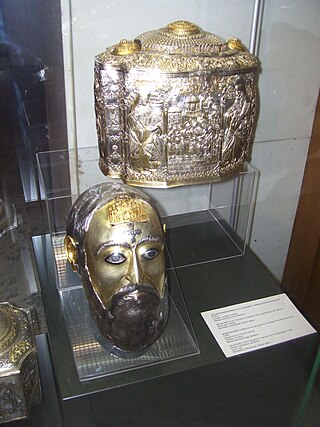
"Servant of the servants of God" (Latin : servus servorum Dei) [1] is one of the titles of the Pope and is used at the beginning of papal bulls. [2]

"Servant of the servants of God" (Latin : servus servorum Dei) [1] is one of the titles of the Pope and is used at the beginning of papal bulls. [2]
Pope Gregory I (pope from 590 to 604), the first Pope to use this title extensively to refer to himself, [3] deployed it as a lesson in humility for the archbishop of Constantinople John the Faster (in office 582-595), who had been granted the traditional title "Ecumenical Patriarch" [4] by a Council convened in Constantinople in 587. [5] Gregory reportedly reacted negatively to the Patriarch's title, claiming that "whoever calls himself universal bishop [the imprecise Latin translation of "Ecumenical Patriarch"],[ citation needed ] or desires this title, is, by his pride, the precursor to the Antichrist." [6]
Theophylact Lekapenos was Ecumenical Patriarch of Constantinople from 2 February 933 to his death in 956.
The Greek Orthodox Archdiocese of Italy, officially the Sacred Orthodox Archdiocese of Italy and Exarchate of Southern Europe, is a diocese of the Ecumenical Patriarchate of Constantinople with its see in Venice. The diocese was created in 1991. The current archbishop and exarch is Polykarpos Stavropoulos.
The Metropolis of Derkoi is a residential see of the Eastern Orthodox Church subject to the Ecumenical Patriarch of Constantinople and situated in the Istanbul suburb of Yesilköy. The cathedral is that of St. Parakevi in Therapia (Tarabya). The metropolitan is a member of the Patriarchal Synod. The present Metropolitan is Apostolos Daniilidis.
Eastern Orthodoxy in France is the totality of all Eastern Orthodox churches in France.
The Metropolis of Hong Kong and Southeast Asia is a metropolis or archeparchy of the Ecumenical Patriarchate of Constantinople in the Eastern Orthodox Church. It is equivalent to an archdiocese in the Catholic Church. It is centred on the city of Hong Kong and has jurisdiction over Eastern Orthodox Christians in Hong Kong, Macao, China, Taiwan, Mongolia, the Philippines, Vietnam, Cambodia, Laos, Thailand and Myanmar. It was established in November 1996 by the Holy Great Synod of Constantinople. The incumbent metropolitan is Nektarios Tsilis.
George of Evdokias was an Eastern Orthodox archbishop who led the Patriarchal Exarchate for Orthodox Parishes of Russian Tradition in Western Europe from 1981 to 1993, under the jurisdiction of the Ecumenical Patriarchate of Constantinople.
Kalinik II was Archbishop of Peć and Serbian Patriarch from 1765 to 1766. He was the last holder of that office before the Ottoman Empire abolished the Serbian Patriarchate of Peć in 1766. As an ethnic Greek, he was seen as a foreigner among Serbs, who favored the deposed patriarch Vasilije I. Since his tenure was marked by various internal conflicts, Kalinik decided to resign his post, and even went a step further: he sent a pre-agreed petition to the Ecumenical Patriarch of Constantinople asking for the abolition of the Serbian Patriarchate of Peć, citing accumulated debts as the main reason for this motion, signed by him and 5 other bishops. On 11 September 1766, the Ecumenical Patriarch of Constantinople convinced the Sultan to abolish the Serbian Patriarchate of Peć and place its dioceses under the jurisdiction of Constantinople. That decision affected only Serbian dioceses under Ottoman rule, since Serbian Autonomous Metropolitanate of Karlovci in Habsburg monarchy remained out of reach of Constantinopolitan Phanariotes.
Joannicius III was Archbishop of Peć and Serbian Patriarch from 1739 to 1746 and Archbishop of Constantinople and Ecumenical Patriarch from 1761 to 1763. The ordinal number of his title is III both for his office as Serbian Patriarch and of Constantinople.
Isidore II Xanthopoulos was Ecumenical Patriarch of Constantinople from 1456 to 1462.
Antony Joasaph I Kokkas was Ecumenical Patriarch of Constantinople in the 1460s. The exact dates of his reign are disputed by scholars at various times ranging from 1462 to 1465.
Sophronius I was Ecumenical Patriarch of Constantinople from 1463 to 1464. The dates of his reign are disputed by scholars in a range from 1462 to 1464.
Mark II Xylokaravis was Ecumenical Patriarch of Constantinople from 1465 to 1466. In 1467 he became Archbishop of Ohrid, a post he held until his death.

Dionysius I was Ecumenical Patriarch of Constantinople two times, from 1466 to 1471 and from 1488 to 1490. He is honoured as a saint in the Eastern Orthodox Church and his feast day is November 23.
Emilianos Zacharopoulos was the first Eastern Orthodox metropolitan bishop of Belgium, Netherlands and Luxembourg, since 1969, under jurisdiction of Ecumenical Patriarchate of Constantinople. In 1983, he returned to Greece, became Metropolitan of Kos and retired in 2009.

Cyril VI, lay name Konstantinos Serpentzoglou, was the Ecumenical Patriarch of Constantinople between the years 1813 and 1818.

Agathangelus was the leader of the Metropolitanate of Belgrade from 1815 until 1825 when recalled back to Constantinople. There he was elected Ecumenical Patriarch of Constantinople during the period 1826–1830.

The Metropolis of Thessaloniki is a Greek Orthodox metropolitan see based in the city of Thessaloniki in Central Macedonia, Greece. It is part of the so-called "New Lands", belonging to the jurisdiction of the Ecumenical Patriarchate of Constantinople but being administered by the Church of Greece. The see traces its history to its foundation by the Apostle Paul in the 1st century. Since 2023, the incumbent metropolitan is Filotheos Theocharis.

The Eparchy of Banja Luka is an eparchy (diocese) of the Serbian Orthodox Church with its seat in Banja Luka, Bosnia and Herzegovina. It has jurisdiction over the north-western regions of Bosnia and Herzegovina.
The Metropolis of Singapore and South Asia is a diocese of the Ecumenical Patriarchate of Constantinople in the Eastern Orthodox Church. It is centered in Singapore and has jurisdiction over Eastern Orthodox Christians in the countries of Singapore, Indonesia, Malaysia, Brunei, East Timor, the Maldives, Sri Lanka, Bangladesh, India, Nepal, Bhutan, Pakistan and Afghanistan. It was founded in January 2008 by the Holy Synod of the Ecumenical Patriarchate of Constantinople.
Cyril was an Eastern Orthodox Metropolitan of Belgrade, from 1825 to 1827. Since Belgrade was capital city of the Principality of Serbia, Cyril was the most senior Eastern Orthodox hierarch in the country. He belonged to the hierarchy of the Patriarchate of Constantinople and previously served as the Metropolitan of Mesembria.
[...] the Patriarch of Constantinople began to be addressed as the 'Ecumenical Patriarch', with the first known use of the title being recorded at the time of Patriarch Acacius (472-89).
A Council held in Constantinople in 587 [...] officially bestowed the title 'Ecumenical Patriarch' on Constantinople Patriarch John IV (582-95). This action caused Patriarch of Rome, Pelagius II (579-90) to sever his connection with Constantinople, while his successor, Gregory I (590-604), sent letters of protest to both Patriarch John IV and Emperor Mauricius (582-602) - but with no results.
Pope Pelagius, who in the first instance opposed this assumption of John the faster, having died very shortly afterwards, the quarrel was taken up by his successor Pope Gregory the Great [...]. [...] and in a letter to the bishop of constantinople who succeeded John the faster, he affirms, that 'whoever calls himself Universal Bishop, or desires to be so called in the pride of his heart, is the forerunner of anti-christ.'